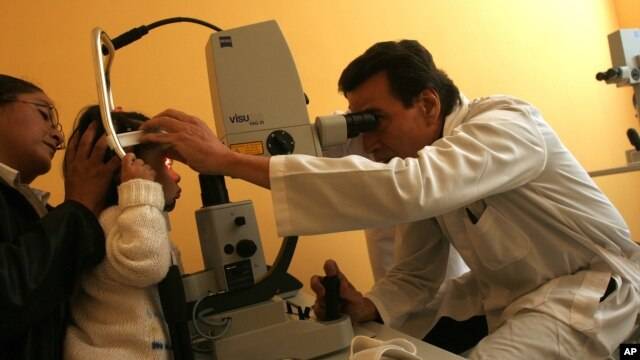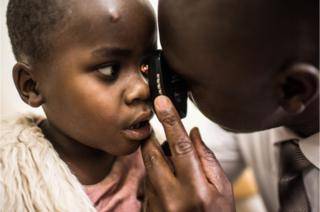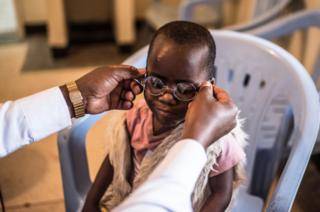Has anyone here undergone the procedure...?
I'm considering it...
and would appreciate any comments, recommendations and/or warnings...
I'm considering it...
and would appreciate any comments, recommendations and/or warnings...
Follow along with the video below to see how to install our site as a web app on your home screen.

Note: This feature currently requires accessing the site using the built-in Safari browser.
Now scientists and doctors have discovered a new technique that not only removes the cataracts, but also stimulates a child's own stem cells to regrow a functioning lens, restoring vision more completely than ever before. The results are reported in the online journal Nature. The research was done by the University of California, San Diego School of Medicine and Shiley Eye Institute, with colleagues in China, and has been tested on animals and in a small human trial that showed impressive results. Congenital cataracts occur at birth or soon after, and cause the lens of the eye to become cloudy. This keeps light from passing through the eye to the retina, and beyond to the brain.

A doctor performs laser microsurgery on a 2-year-old with congenital cataracts at the Ophthalmology Institute in La Paz, Bolivia, April 26, 2006. Researchers now have discovered a technique that removes the cataracts, and stimulates a child's stem cells to regrow a functioning lens.
Current treatment depends on the age of the patient and a host of other related complications. Surgery is often required, and almost all patients require corrective eyewear after cataract surgery. The researchers tried a less invasive approach. The goal, they said, was not only to get rid of the cloudy lens, but to coax the body to use leftover stem cells to heal itself. "An ultimate goal of stem cell research is to turn on the regenerative potential of one's own stem cells for tissue and organ repair and disease therapy," said Kang Zhang, founding director of the Institute for Genomic Medicine.
Less invasive approach
From birth, a person's eyes have a number of what scientists call lens epithelial stem cells or LECs. They live in the eye and generate replacement lens cells throughout a person's life, though production declines with age. Current cataract surgeries remove almost all of these LECs, so they regenerate lens cells in a 'disorganized' way that doesn't help heal or reconstruct the actual lens. So researchers combined a new surgical technique that is much less invasive and retains the shape of the lens, with a therapy that stimulates the LECs to grow. They tried the technique on animals, and then in a small human trial of twelve infants.
Helping body heal itself
The results were impressive: All 12 patients had fewer complications post-surgery. They healed faster, and after three months, the LECs had rebuilt a clear, regenerated biconvex lens in the eyes of every patient. "The success of this work represents a new approach in how new human tissue or organ can be regenerated and human disease can be treated, and may have a broad impact on regenerative therapies by harnessing the regenerative power of our own body," Zhang said. With this success under their belt, the researchers are shifting their focus to older patients with age-related cataracts, which are the leading cause of blindness in the world.
Cataract Surgery Helps Stem Cells Restore Vision
this is a 5 yr old thread...i wonder if he did it or not

For the first six years of his life Criscent Bwambale was one of 18 million people in the developing world currently estimated to be living with preventable blindness. He was born with cataracts, able to make out only vague areas of light and dark. In Uganda, where Criscent lives with his grandmother in a mud-built house surrounded by cocoa plantations, that means almost total exclusion from normal life. He couldn't go to school or play with other children his age, and had to rely on his family for even the most basic tasks. In January, the family responded to a call from a Ugandan medical team supported by international charity Sightsavers, to submit their children for eye tests, which resulted in Criscent undergoing double cataract surgery at a hospital in Mbarara to the west of the country.

Two months later, vision therapist Nelson Chwa examines Criscent's eyes before fitting him with spectacles, allowing him to see the world clearly for the first time.

A doctor puts new glasses on Criscent for the first time.
Old spectacle frames lie in a box at the Ruharo Eye Hospital, one of the few clinics offering specialist services for Uganda's estimated 368,000 blind people.

Criscent strides out of the Eye hospital with his new glasses. "Before the operation he relied on his grandmother or another member of his family to do everything for him. But now he's a confident and independent little boy," said Joseph Magyezi, a hospital official.

On the journey back to his home village of Bundibugyo, Criscent looks out of the car window with amazement.
The road passes through spectacular scenery in the foothills of the Rwenzori mountains in the far west of the country.

Back home, Criscent's cousin lifts him up to show him the view out of the window. His family now have the task of teaching him what basic everyday objects are. "His siblings are all happy and excited. They are all elated that their brother can now see," said his grandmother.
MORE
Has anyone here undergone the procedure...?
I'm considering it...
and would appreciate any comments, recommendations and/or warnings...
Stem cell cataract surgery helps restore vision in children...
Cataract Surgery Helps Stem Cells Restore Vision
March 09, 2016 - Congenital cataracts are estimated to be responsible for between 5 and 20 percent of all cases of blindness in children worldwide.
Now scientists and doctors have discovered a new technique that not only removes the cataracts, but also stimulates a child's own stem cells to regrow a functioning lens, restoring vision more completely than ever before. The results are reported in the online journal Nature. The research was done by the University of California, San Diego School of Medicine and Shiley Eye Institute, with colleagues in China, and has been tested on animals and in a small human trial that showed impressive results. Congenital cataracts occur at birth or soon after, and cause the lens of the eye to become cloudy. This keeps light from passing through the eye to the retina, and beyond to the brain.

A doctor performs laser microsurgery on a 2-year-old with congenital cataracts at the Ophthalmology Institute in La Paz, Bolivia, April 26, 2006. Researchers now have discovered a technique that removes the cataracts, and stimulates a child's stem cells to regrow a functioning lens.
Current treatment depends on the age of the patient and a host of other related complications. Surgery is often required, and almost all patients require corrective eyewear after cataract surgery. The researchers tried a less invasive approach. The goal, they said, was not only to get rid of the cloudy lens, but to coax the body to use leftover stem cells to heal itself. "An ultimate goal of stem cell research is to turn on the regenerative potential of one's own stem cells for tissue and organ repair and disease therapy," said Kang Zhang, founding director of the Institute for Genomic Medicine.
Less invasive approach
From birth, a person's eyes have a number of what scientists call lens epithelial stem cells or LECs. They live in the eye and generate replacement lens cells throughout a person's life, though production declines with age. Current cataract surgeries remove almost all of these LECs, so they regenerate lens cells in a 'disorganized' way that doesn't help heal or reconstruct the actual lens. So researchers combined a new surgical technique that is much less invasive and retains the shape of the lens, with a therapy that stimulates the LECs to grow. They tried the technique on animals, and then in a small human trial of twelve infants.
Helping body heal itself
The results were impressive: All 12 patients had fewer complications post-surgery. They healed faster, and after three months, the LECs had rebuilt a clear, regenerated biconvex lens in the eyes of every patient. "The success of this work represents a new approach in how new human tissue or organ can be regenerated and human disease can be treated, and may have a broad impact on regenerative therapies by harnessing the regenerative power of our own body," Zhang said. With this success under their belt, the researchers are shifting their focus to older patients with age-related cataracts, which are the leading cause of blindness in the world.
Cataract Surgery Helps Stem Cells Restore Vision